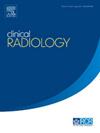探讨基于PI-RADS v2.1和机器学习模型的多参数和双参数MRI在前列腺癌诊断中的作用。
IF 1.9
3区 医学
Q2 RADIOLOGY, NUCLEAR MEDICINE & MEDICAL IMAGING
引用次数: 0
摘要
目的:采用前列腺影像学报告和数据系统(PI-RADS) 2.1版本,比较多参数MRI (mpMRI)和双参数MRI (bpMRI)对临床显著性前列腺癌(csPCa)的诊断性能。此外,我们构建了多个机器学习(ML)模型,用于使用PI-RADS评分和临床参数检测csPCa。材料和方法:我们招募了583例594个病变的患者,他们在MRI/经直肠超声(MRI- trus)融合靶向活检和系统活检之前进行了mpMRI检查。采用曲线下面积(AUC)分析bpMRI和mpMRI的诊断效能。我们建立了多个ML模型来检测csPCa。输入参数为:bpMRI或mpMRI的PI-RADS评分、年龄、前列腺特异性抗原(PSA)、mri定义的PSA密度(PSAD)和前列腺体积(PV)。训练组和试验组分别包括475例和119例病变。结果:bpMRI和mpMRI诊断全病变csPCa的AUC分别为0.88和0.90 (p结论:基于PI-RADS v2.1的mpMRI诊断csPCa的AUC高于bpMRI。使用PI-RADS评分和临床参数检测csPCa的ML模型在mpMRI和bpMRI之间具有优异的诊断性能和可比性。本文章由计算机程序翻译,如有差异,请以英文原文为准。
Investigating the role of multiparametric and biparametric MRI based on PI-RADS v2.1 and machine learning models in prostate cancer diagnosis
Purpose
We compared the diagnostic performance of multiparametric MRI (mpMRI) and biparametric MRI (bpMRI) in detecting clinically significant prostate cancer (csPCa) using the Prostate Imaging Reporting and Data System (PI-RADS) version 2.1. Additionally, we constructed multiple machine learning (ML) models for detecting csPCa using PI-RADS scores and clinical parameters.
Materials and Methods
We enrolled 583 patients with 594 lesions who underwent mpMRI before MRI/transrectal ultrasound (MRI-TRUS) fusion-targeted biopsy and systematic biopsy. The diagnostic performance of bpMRI and mpMRI was analyzed by the area under the curve (AUC). We built multiple ML models for detecting csPCa. The input parameters were: PI-RADS scores in bpMRI or mpMRI, age, prostate-specific antigen (PSA), MRI-defined PSA density (PSAD), and prostate volume (PV). Training and test cohorts included 475 and 119 lesions, respectively.
Results
The AUCs of bpMRI and mpMRI for the diagnosis of csPCa in total lesions were 0.88 and 0.90, respectively (p<0.05). mpMRI had higher sensitivity (93.1%) but lower specificity (77.3%) compared to bpMRI (sensitivity: 79.2%; specificity: 86.2%). All the ML models exhibited the high AUC in detecting csPCa (0.93–0.96 based on mpMRI models and 0.91–0.94 based on bpMRI models). There were no statistically significant differences in the AUC values between the two groups of ML models in test sets.
Conclusions
Compared to bpMRI, the AUC of mpMRI based on PI-RADS v2.1 to detect csPCa was higher. The diagnostic performance of ML models for detecting csPCa using PI-RADS scores and clinical parameters was excellent and comparable between mpMRI and bpMRI.
求助全文
通过发布文献求助,成功后即可免费获取论文全文。
去求助
来源期刊

Clinical radiology
医学-核医学
CiteScore
4.70
自引率
3.80%
发文量
528
审稿时长
76 days
期刊介绍:
Clinical Radiology is published by Elsevier on behalf of The Royal College of Radiologists. Clinical Radiology is an International Journal bringing you original research, editorials and review articles on all aspects of diagnostic imaging, including:
• Computed tomography
• Magnetic resonance imaging
• Ultrasonography
• Digital radiology
• Interventional radiology
• Radiography
• Nuclear medicine
Papers on radiological protection, quality assurance, audit in radiology and matters relating to radiological training and education are also included. In addition, each issue contains correspondence, book reviews and notices of forthcoming events.
 求助内容:
求助内容: 应助结果提醒方式:
应助结果提醒方式:


